How Cannabis Plants Use Water and What To Know
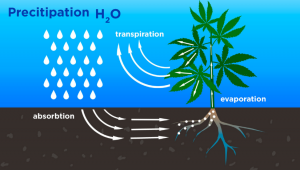
- 1. Understanding transpiration
- 1. a. Transpiration through the foliage
- 1. b. Transpiration through the roots
- 1. c. What can go wrong?
- 2. The ideal growing medium for water retention
- 3. The different types of water to consider
- 3. a. Hard water
- 3. b. Soft water
- 4. Reverse osmosis
- 5. Rain water
- 6. Top tips on watering cannabis plants
- 7. How often, and what quantity of water do you need to give to your crop?
- 7. a. How to gauge when your plants are thirsty
- 8. Other vital components for a succesful crop
- 9. In conclusion
Water is an essential building block for all carbon based life forms that exist on the planet. Especially when it comes to cannabis seeds that require large amounts of nutrient solution on a regular basis. Having the discipline to not over water or underwater your plants is one thing, however, understanding how and why Cannabis plants use water in the first place is the key factor. Below Fast Buds better explain all you need to know about water, transpiration as well as our top tips.
1. Understanding Transpiration
The best way to think about how transpiration works with plants, is to relate it to our own human bodies. We rely on water to keep our brain hydrated, allow salts and osmosis to occur, keep our kidneys and other organs functioning and is our body’s natural defense to cooling us down when we sweat.
Now if you imagine how a Cannabis plant depends on water to function in the same way we do, then you can consider how they use water to maintain salt levels and nutrient uptake.
Transpiration Through The Foliage
One way in which Cannabis plants will utilize water is through their leaves. The amount of relative humidity present can play a role in how much water the plants release through their leaves, or in fact how much water is absorbed by the root zone.
Transpiration Through The Roots
The main network of the Cannabis plant that is responsible for sourcing nutrients. The root hairs only need to tap into a very thin film of water to access available nutrients. Now on the basis that the humidity levels meet the requirements of the plant’s life cycle, the ratio of nutrient uptake to transpiration through the foliage should be perfectly balanced.

The amount of moisture a growing medium is capable of holding can be up to 18 times its own weight, however, the rate of transpiration via the foliage rapidly fluctuates. In order to overcompensate for a dry and harsh environment such as the Mediterranean in the peak of Summer, or a badly ventilated indoor garden, plants must cool themselves down very much the same we do after demanding physical exercise.
What Can Go Wrong?
When an environment becomes too hot for a Cannabis plant, and all of the water from the root zone has been used up, it is just a matter of time before the plants will lose their essence and diminish in vigor. This will also cause a list of deficiencies to occur and for the plants to ultimately suffer in growth and performance.
- E.C Levels can fluctuate
- Plants can become stunted
- Deficiencies will occur
- Visible leaf damage
2. The Ideal Growing Medium For Water Retention
It is very important to have a fine balance within your growing medium of water retention, and drainage. The ratio and substrate a grower uses can very much determine how fast or slow transpiration will take place.
Rockwool
Rockwool can hold up to 18 times its own weight in water, meaning it is an excellent substrate for holding onto water during hot spots indoors or outdoors. More commonly used in hydroponics, it is a great additive to use at the very base of pots, or within a mixture of coco, perlite, and soil.
Coco
Coco fiber is made up of coconut husks and packaged as an inert growing medium. An extremely user-friendly and plant-friendly substrate that has incredible air capacity, as well as water retention. Growing Cannabis in coco is often performed in hydroponics, or as a blend into organic living soils.

Vermiculite
Vermiculite is a hydrous phyllosilicate mineral that expands under intense heat. Another inert medium that is lightweight and can keep a growing medium well-saturated.
3. The Different Types of Water To Consider
Depending on which part of the country you live in, it can play a massive role in the water source that will be used for your indoor or outdoor plants. As well as how you access the water by tap, local town deposits, or by collecting rainwater.
Hard Water
This described the mineral-rich content of the water that has been leached minerals from rocks. Hard water has a far higher mineral content due to percolation through deposits of chalk, gypsum, and limestone. These leech off into the water, meaning the water becomes rich in:
- Calcium
- Magnesium
- Magnesium carbonates
- Bio carbonates
- Sulfates
You can boil a saucepan of hard water and will notice a white, chalk-like substance left behind in the saucepan. This is the easiest way to test the hardness of your water.
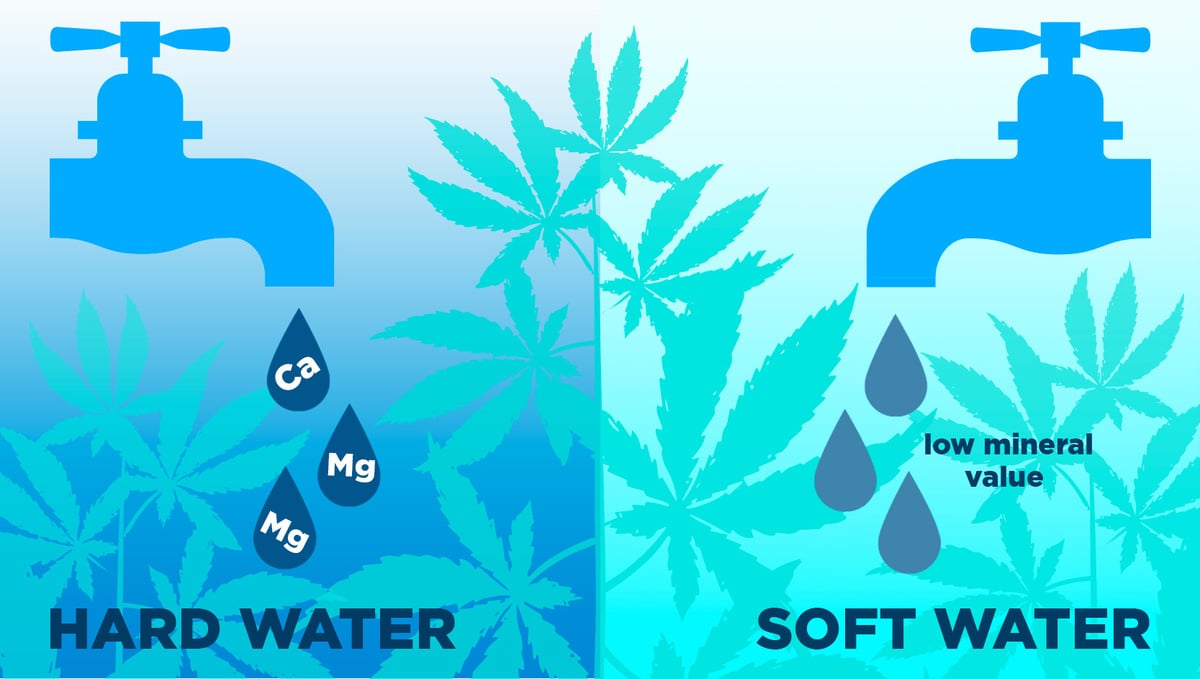
Soft Water
Soft water has a very low mineral value and is low in ions, in comparison to hard water. As the name suggests, the water itself when drinking is very soft with very little aftertaste. It may be wise to supplement your garden with a Calcium and Magnesium nutrients, to maintain the balance between primary nutrients and trace elements
- Low ions of Magnesium
- Low ions of Calcium
- Requires Cal + Mg supplement
4. Reverse Osmosis
A method that purifies water by removing ions and larger-sized particles from drinking water is reverse osmosis (R/O). This is an excellent way to reduce the electric conductivity (E.C) to the lowest starting point and then add nutrients accordingly. An excellent solution for growers who suffer from poor water quality and rely on a filtering process that is adequate for safe drinking, external use and most importantly feeding Cannabis plants and maintaining the optimum living soil conditions.
5. Rain Water
Unfortunately, the days of collecting clean and free rainwater are over, with parts of the world now restricting the collection of rainwater. If you are currently relying on Mother Nature for a free water source, or are considering starting doing so, then it is important to consider the following:
- As rain water falls to the ground, it pulls ions from the air and traps them in the water drops. If you live close to a major town, then be careful the air pollution will not affect the rain and cause it to become toxic or unusable for plants or drinking.
- Make sure that the materials being used to collect the rain are clean and sterile. An old drainpipe or rusty corrugated steel roof may cause contaminants to leach into the water over time. Using plastic corrugated sheet works very well, and make sure you thoroughly clean out drain pipes that will collect the water.

- It is important to store the collected rainwater in darkness with high amounts of dissolved oxygen and well out of direct sunlight. Doing so will prevent algae and anaerobic bacteria from beginning to form.
6. Top Tips On Watering Cannabis Plants
- Watering your plants close to the grow lights and switching them off can cause excessive humidity levels and for the growing medium to become oversaturated during the darkness period. It is much more beneficial and practical for the plants to be fed once an hour after the lights turn on, or twice a day in smaller intervals.
- Use an airstone or pump to keep your water aerated and oxygen-rich. It is impossible for bad bacteria to live in a highly oxygenated environment. Not only will adding oxygen to keep your reservoir fresh, but it will also increase the pH at the same time.
- In the event, your plants have been treated with stagnant water, or have formed pathogens, then an excellent remedy is to use hydrogen peroxide. The additional oxygen molecule attached to the H2O will kill off any disease or infection.
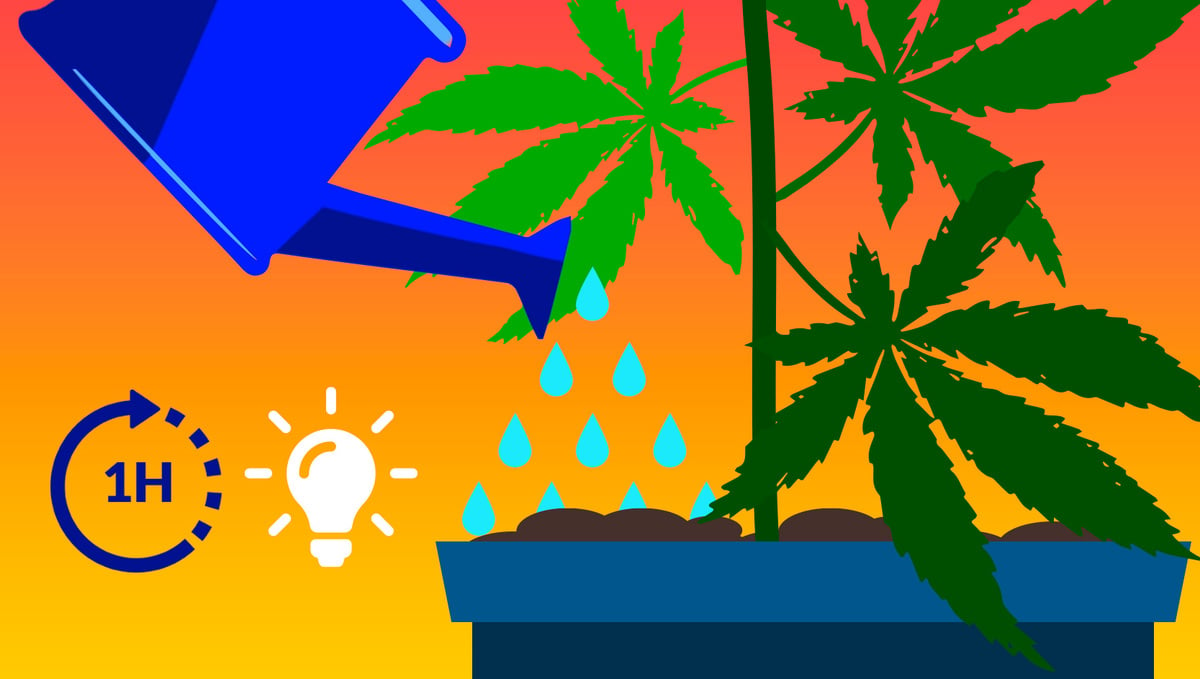
- Reverse osmosis is well recommended for growers who have access to a hard water source. It may take time to filter and purify the water, however, the end result will be safe to drink and a contaminant-free water source.
7. HOW OFTEN, AND WHAT QUANTITY OF WATER DO YOU NEED TO GIVE TO YOUR CROP?
We are going to base our answer here on the coco-coir cultivation method, as this is the best medium for beginners. This is actually a pretty tricky question to answer as the science is anything but exact, and there is a smorgasbord of elements that can affect how often you need to water your plants, and the quantity required. Let’s have a quick run-through of all the factors you need to take into consideration when trying to work out exactly how much and how often to water your crop.
The Growing Medium
The growing medium you choose for your weed has a pretty huge impact on how much water is needed. Cannabis plants tend to thrive in highly aerated, shaggy, and rich mediums that drain super well. The lighter and shaggier the better. We always recommend that new growers opt for a coco-coir-based medium, with additions like perlite or vermiculite to increase the drainage and aeration. We also choose to grow in air pots, but if you can only find regular plastic pots then you should add some extra drainage holes at the bottom, and some clay balls underneath the growing medium to promote good drainage.
There are a couple of reasons why we always want quick and efficient drainage. When a pot holds onto its moisture for excessive periods, it can lead to issues such as root rot, nutrient lockout or deficiencies, pest infestations, and fungal growth. A compact and moisture-heavy growth medium is also much harder to flush, should you run into any nutrient issues. A good rule of thumb is that you want your water to flush through the medium pretty quickly. You should see runoff escaping the drainage holes within the first minute or two after draining. If the medium doesn’t totally dry out after 72 hours or so (24 hours is what you should be aiming for), then it is holding too much moisture. Before you plant anything you should test the water retention of the growing medium you plan to use and make any amendments necessary. Check out this post for a full guide on growing in coco-coir.
The Pot Size
The size of the pot has a big effect on the watering schedule. For photoperiod plants, it is good to start in a small pot and slowly increase the size as the plant grows, but for autos, it’s better to start them in the pot they will finish in. This is due to the fact that every time you transplant from one pot to another you stress the plant, which is fine for photoperiods as you can just keep them in the vegetative growth stage for a few extra days. Autoflowering plants will switch to the flowering stage under any light conditions, so we don’t have the luxury of extending the growth stage. For autos, a pot size anywhere between 6 to 15 liters is advised, depending on the style of grow you plan on running. Start with light watering, and don’t worry about seeing run-off until the plants are at the 3-week mark at minimum.
The Stage of Growth
As we have already briefly gone over, the stage of growth will directly affect how much water you need to provide. When the plants are very young they will require only small amounts of water. Avoid watering small plants with heavy streams, as this may stress or even damage the plant - a mister will work perfectly to just moisten the substrate surrounding the plant.
As the plants grow larger, so do their appetite. At the 3 week mark, you can start totally soaking the medium until you see run-off. Before this point, you should flush the medium once every week or so to avoid salt buildup. Once you are watering to runoff, you want to see about 25% of the feed watering exiting the pot.
Environmental Factors and Light Intensity
The intensity of the light setup, the humidity, and the ambient temperature of your grow room can have a huge impact on how often you will need to water your crop. Keep a close eye on your crop, and feel the weight of the pots every time you check them - which should be every single day.
How to Gauge When Your Plants Are Thirsty
The weight test is the easiest way to check how much of the feed water your plants have taken in. This may seem pretty unexact to new growers, but you will quickly get used to the different weights of your pots to the point where you will easily be able to tell how much moisture is still in the pots. If your plants look tired and droopy they could be suffering from a disease or a possible pest infestation, or they could just need good water.
One issue here though is that over-watered plants will also look droopy, but a telltale sign of overwatering is the plants displaying a very dark green color, with the leaves curling inwards and down. If your plant is displaying yellowing or browning at the tips of the leaves, this could very well be a sign of underwatering. Are the leaves a little crispy? Give the plant some water! You can also dig one finger into the topsoil to a depth of an inch and a half or so. This can give you an indication of overall water levels, but in general, it is best to use the previously mentioned methods.
8. Other Vital Components for a Succesful Crop
So, there we have it. Everything there is to know about cannabis crop hydration, and all the ways to manage it. But it takes more than just water to get the job done. To truly maximize your cannabis crop growth and bud production, there are a few other critical elements to consider. If you are growing organically in super soil then you can cut a few of these elements away, as the soil will provide all the nutrients the crop needs, but if you are growing with a hydroponic setup or with coco-coir as your main growing medium then you will 100% need to consider the nutritional consumption of the crop.
And it's not just water and nutrients. Nope, there is a range of elements and environmental controls that must be thought about when designing a successful cannabis crop. Lighting, temperature, humidity, and ventilation are also important factors that need to be considered when setting up a cannabis crop for success. Let's take a quick look at all of them and explain why they're important.
Nutrients
Cannabis plants need a range of macro, secondary, and micronutrients to thrive and produce large, dense buds. The macro (or most important) nutrients are Nitrogen (N), Phosphorus (P), and Potassium (K). These are the base nutrients that need to be supplied in the largest doses, but they are anything but the only nutrients that the crop needs. Other important secondary nutes include magnesium (Mg), calcium (Ca), and sulfur (S) - and then there are the micros which include boron (B), manganese (Mn), zinc (Zn), copper (Cu), iron (Fe), and molybdenum (Mo). All good nutrient ranges should have a balanced mix of all of these, but always check the bottle to make sure.
Oxygen and CO2
This may seem a little obvious, but just like all living beings on this pale blue dot, cannabis plants need access to both oxygen and carbon dioxide to survive. Oxygen helps the plant to power its metabolic functions, while CO2 is used in photosynthesis.
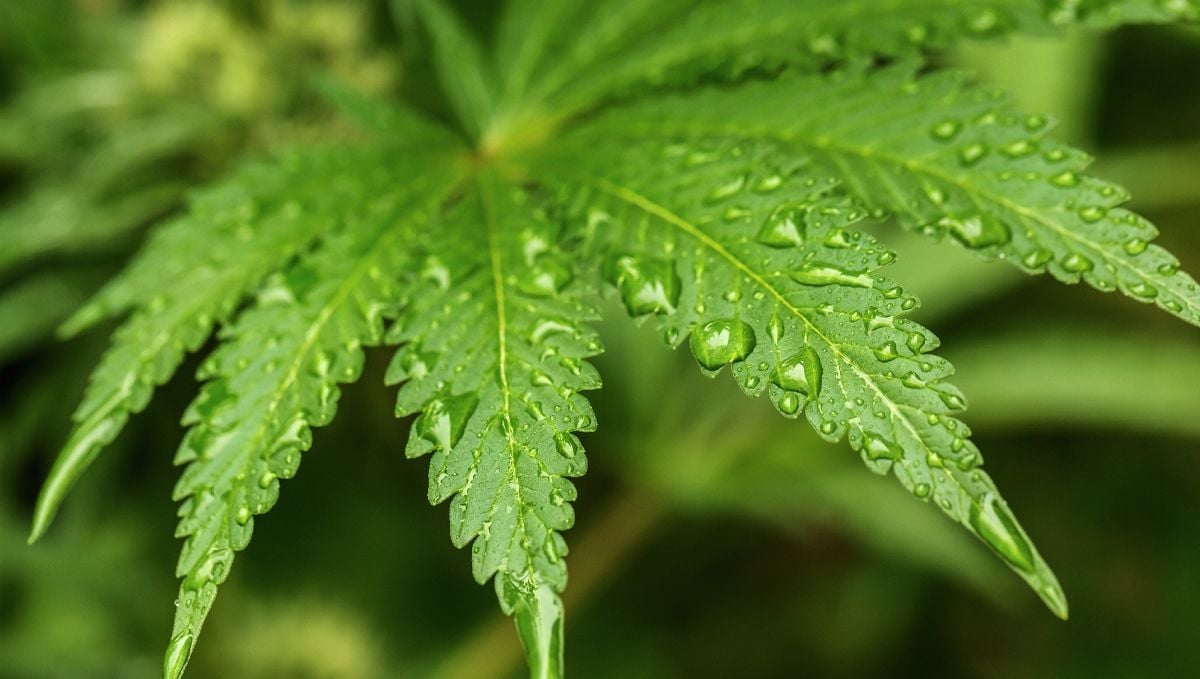
Together they form a vital part of the cannabis plants' life cycle, and so it is essential to maintain healthy levels of them both in the grow space and in the root zone.
Temperature
Cannabis plants prefer a temperature range of 68-77°F (20-25°C). High temperatures can decrease plant vigor, while low temperatures can stunt growth completely. If you are growing outdoors it can be tricky to force the temperatures to stay within this range, but a greenhouse can give you more control over the environment and make it much easier to maintain a healthy temperature range.
Humidity
Humidity is another important factor that needs to be kept in check. The Ideal humidity level changes as the plant develop, but in most cases should sit between 40-60%. Germinating seeds and seedlings like it closer to the 70% mark. Once full vegetative growth is underway that can be dropped down to 50-60%, and then again after the fourth week of flower to 40-50%.
Lighting
Lighting is key. The right light will make or break your cannabis crop, and while there are a bunch of different types of lighting options, only one really makes sense in 2023 and onwards. For the longest time, HID lighting rigs reigned supreme as the gold standard for indoor crops. But, thanks to LED technology coming along in leaps and bounds in recent years, that is no longer the case. LEDs are now the go-to choice for indoor cannabis growers due to:
- Their lower power consumption needs - they use less than half the power of HID options.
- Their high-efficiency rating - they produce more useful light than HID options, but in a smaller form factor.
- Their low operating temperature - they don’t get as hot as HID so you don’t need to invest in fans and cooling systems.
- Their long lifespan - they will outlast traditional bulbs by a long way.
- They provide the full spectrum of natural light - unlike HID options that only provide a small section of the lighting spectrum, some LEDs provide the full spectrum of natural light, which allows you to tune in the spectrum you like or provide the full spectrum to your crop.
Always choose a full spectrum, quantum board LED panel. If you can't afford an option like this, save until you can - it's really that simple. They are just, excuse the pun, lightyears ahead of the competition.
Ventilation and Air Exchange
Ventilation and air exchange are vital for keeping your grow space cool, as well as providing the plants with fresh CO2. Without adequate air exchange, temperatures will rise, CO2 levels will drop and mold spores may start to grow. Invest in ventilation systems such as inline fans and ducting for air exchange, and a couple of oscillating fans to ensure the canopy air stays fresh.
Carbon filters are another vital piece of kit to ensure the air quality in your grow space is maintained. They also trap all of the delicious, stanky aromas that may otherwise escape. Discretion is key, my friends, even if you live in a location that allows cannabis cultivation.
9. In conclusion
When it comes to watering Cannabis plants, there are many variables to consider. Not only does the maturity of the plant, pot size, growing medium, light intensity, air intake, temperature, and humidity play a role, but also the cultivar and the experience level and understanding of the grower. Learning how much water and nutrient solutions your plants need is a big difference-maker in the final harvest and quality of your crop. Good luck finding the perfect balance and growing some top-shelf flowers!









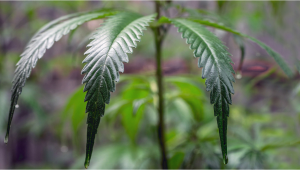


Comments